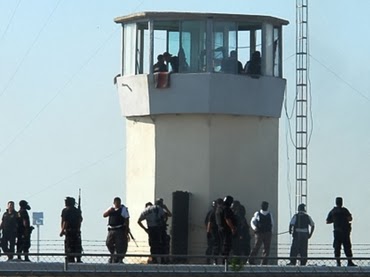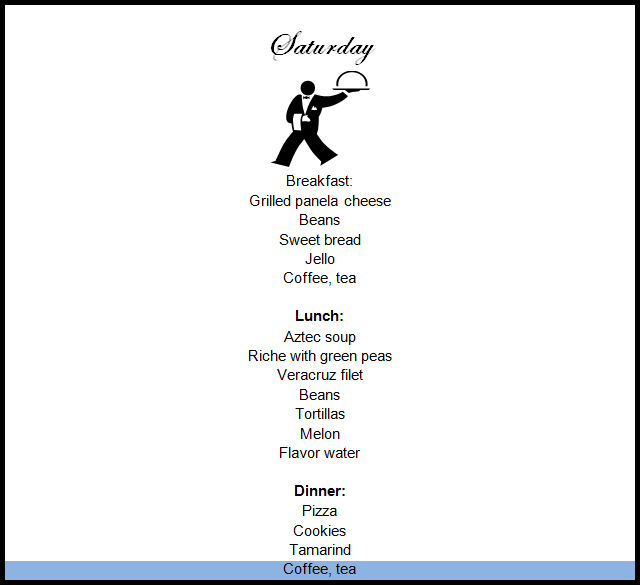From the menus [click any image to enlarge], to the private visiting rooms, sans bars, she has been criticized for her approach, which her detractors tag as dangerous and “soft”.
“I am asked; hey why do so many things for the offenders, how do you think the victims feel? “
“I answer that my role is not working with the victims; it is to work with offenders, to rehabilitate, so in that way the institution does something for the victims, and society, by working for the prevention of crime. “
Other features of Quintanilla’s prison plan for inmates are offering education through high school, and work shop and training, utilizing outside businesses contacted with the prison.
The prison population has grown to 1,200 inmates with plans for expansion. 250 inmates are deemed “high risk” or “dangerous”, having been sentenced for Offences of Drug Trafficking, kidnapping, Organized Crime operations.
As for fear, she maintains healthy fear is good, it keeps you alert in your surroundings, allows good decisions, but the type of fear that can be paralyzing to the point of paranoia, you will miss signs and that can result in you losing your life.
According to information made public in 2011 the cost to feed inmates was about 4 USD per day. There are no current figures made public. I can say from personal experience, the kitchens I have constructed in Mexico for impoverished children serve meals at 12 cents or less per meal.
The state entered agreement with the foundation to; train volunteers [usually mothers] to prepare food and hygiene, a certified nutritionist creates the balanced menu, and the food is delivered to the site and we are charged government or surplus prices.
The meals are nutritious but far from the fancy food on the narco-menus. We serve breakfast for the morning school session, and dinner for the afternoon. Food ranges from pancakes, scrambled eggs, fruit and carton of milk for breakfast, to ham and cheese sandwich, fresh fruit, soup and juice or milk for dinner, everything is prepared fresh on site in our kitchens. We also use a lot of soy which the children like. We supplement the meals with a snack, such as a biscuit and drink, or frozen fruit bar depending on the weather.
The meals from No.1 presents a good case of “What’s wrong with this picture??”
From El Universal, below is a video tour of the prison with Quintanilla translated narrative follows.
Video narrative no 1 Altiplano
Max-Prison menu: What do incarcerated capos eat?
How much does it cost for Mexicans to feed the inmates of the Altiplano penitentiary, maximum security prison that lodge some of the most dangerous criminals of the world of drug trafficking…..continues next page…
Aztec soup [tortilla soup], fried chicken and pizza are just some of the meals that prisoners such as Edgar Valdez Villarreal, aka La Barbie, Jose Jorge Balderas aka El J.J., Osvaldo Garcia Montoya aka El Compayito or Teodoro Garcia Simentel aka El Teo or El Tres Letras (3 letters), among others, enjoy.
A meal that may not be as sophisticated as these characters are used to eating when they were free, it is richer in nutrients and reaches the balanced classification and the stability of the nutritional pyramid that it is requires by the experts and of course to which most of the Mexicans don’t have access to.
Well, the last official information that we have regarding this, was given on September of 2012 throughout the informative media Vanguardia, which quotes as its source; El Universal in Mexico State, who made a visit to such penitentiary
Reporter:
For 21 years, the penitentiary of maximum security of Altiplano in La Palma, Mexico State has been defined as a fortress in which 1,200 inmates, considered by justice as the most dangerous of the country, serve their sentence. It is impossible to go in unless you have authorization from Government Secretariat and up until now, there has not been any inmate that has escape from it.
Directing this federal penitentiary is Marissa Quintanilla, whose job is not limited to her office. All day including dawn, she goes to several areas and allowed El Universal accompany her during her daily tour.
Marissa speaking:
These are the familiar visiting rooms; they are individual (per inmate)
We have light equipment, sound and screens for movies; we regularly have activities every day, in the morning and afternoon. Practically, all cultural events are celebrated here, the event of (inaudible), masses; events with their relatives are done in this auditorium.
Today we have this menu: noodle soup, rice, picadillo (ground meat with potatoes), beans, tortillas, horchata flavor water and apple for dessert. All these kitchen utensils can propose a risk that is why we have precise control of each of the utensils. The only person allowed to enter is the person responsible using the fingerprint reader. Every one of the utensils are numbered and engraved.
Entry is also generated by using fingerprints. We use the shadow system, so we know, for example, say we loan this (screwdriver), I am not showing the name, we have the card of the person that borrowed it and we have registration log, so when the shift ends, they have to come and leave the tool, take their card and register their exit. Everything is perfectly controlled. Every tool has its inventory number engraved and painted.
It is an established laundry program; we pick up the uniform from the inmates. The uniforms consist of three changes, but each change is washed every eight days and the bedding, jackets, and blankets are washed every 15 days.
Here is the library; the inmates don’t come in here, what we do is that we take books in a cart to their dorms. They have the opportunity of getting two books and they can exchange them in, eight days but they have to do a summary of the book they read.
Reporter:
Under the new integral model of social reinsertion, the Director Quintanilla explained that along with her work team, are focused in humanizing the federal penitentiary system, generating more activities for the inmates in a less restricted environment. Until now, the results have allowed the penitentiary to be one of the most peaceful penitentiaries of the country.
Video:
from Victor Figueroa and information from Doris Comora: El Universal Television






